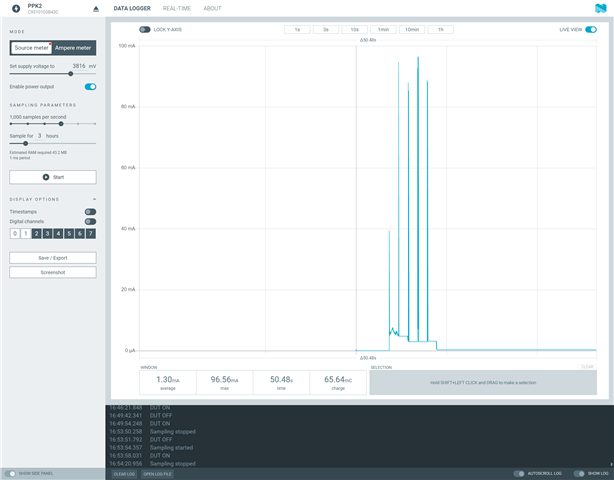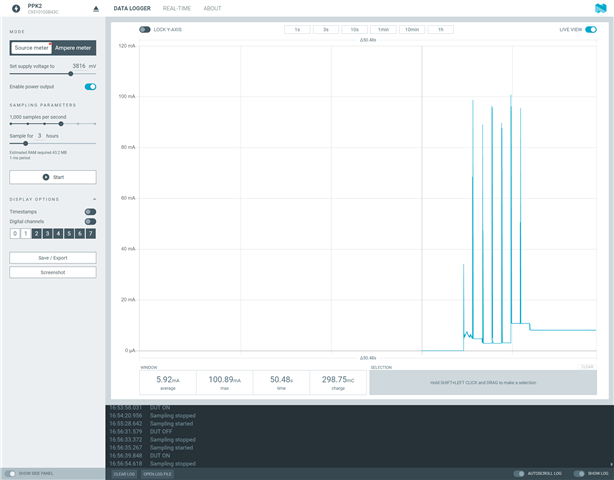My project uses nRF52832 and I'm at the point of the project where I'm trying to minimize power consumption.
To assist in this, I created a very small main() that goes through all my peripherals/subsystems and turns them on, then off in one second intervals. Using PowerProfiler II, I can then watch the power consumption and make sure that when I'm turning things off, I get back to the level where I was before the peripheral/subsystem was turned on.
I added each peripheral, one at a time, turning each on, then waiting 1 second, then turning it back off. I also "beep" a buzzer, causing a "spike" in the power plot so it is easier to see where things are happening. At the end of the "run" a call to nrf_pwr_mgmt_run(); drops to power to the idle level.
Things work well until I get to the UART. I'm using nrf_libuarte_async_init() to turn the UART on, then enable Rx to get things going. This is followed by a call to nrf_libuarte_async_uninit() to supposedly turn the UART back off. The power level drops a bit, but not nearly back down to the level it had been. Something within the driver/lib must continue to run (besides the peripheral power still being on), as the nrf_pwr_mgmt_run() doesn't seem to do anything.
I saw a posting that suggest some low level calls to turn the actual UART off, but these don't seem to do anything to the power profile.
Can you suggest the proper sequence to get the UART back off?
Thanks!
Here is a power profile plot without the UART.

You can see the "spikes" that indicate where other peripherals have been turned on or off. The final step down is where the nrf_pwr_mgmt_run() occurs.
Here is a power profile plot with the UART:

You can see a couple of additional spikes for the UART. The large step up is where the UART is turned on. The small step down is where the UART is turned off. The expectation is that the power level should go back to where it was before turning on, then fall lower when the nrf_pwr_mgmt_run() is called.
Here is the code for initialization and turnoff of the UART.
void
uart_init(void) {
ret_code_t err_code;
// Set the configuration items
nrf_libuarte_async_config_t nrf_libuarte_async_config = {
.tx_pin = USB_UART_RXD_PIN,
.rx_pin = USB_UART_TXD_PIN,
.baudrate = NRF_UARTE_BAUDRATE_9600,
.parity = NRF_UARTE_PARITY_EXCLUDED,
.hwfc = NRF_UARTE_HWFC_DISABLED,
.timeout_us = 100,
.int_prio = APP_IRQ_PRIORITY_LOW
};
// Initialize the UART/library
err_code = nrf_libuarte_async_init(&UART0,
&nrf_libuarte_async_config,
uart_event_handler, (void *)&UART0);
APP_ERROR_CHECK(err_code);
// Enable the UART receiver
// nrf_libuarte_async_enable(&UART0);
}
void
un_init_uart(void) {
nrf_libuarte_async_uninit(&UART0);
// From article https://jimmywongiot.com/2021/05/23/advanced-uart-driver-libuarte-on-nordic-nrf5-sdk/
*(volatile uint32_t *)0x40002000 = 0;
*(volatile uint32_t *)0x40002000;
*(volatile uint32_t *)0x40002000 = 1;
}
Note that for the last trial run, I commented out the nrf_libuarte_async_enable(&UART0); call, thinking that perhaps it might give a hint of what might be causing the problem.
Here is the section of the "main" code where the UART calls are made...
... disableAccel(); #if 1 buzz(30); nrf_delay_ms(1000); uart_init(); buzz(30); nrf_delay_ms(1000); un_init_uart(); #endif buzz(30); ...
Thanks again...


